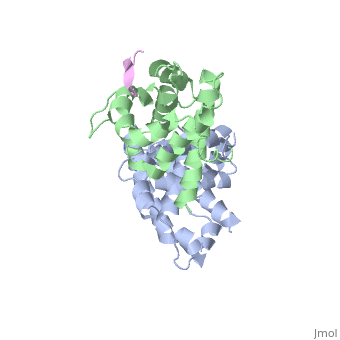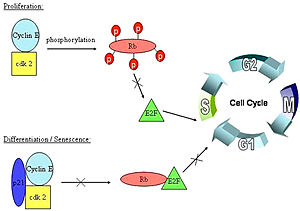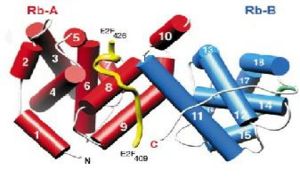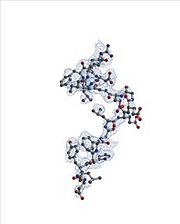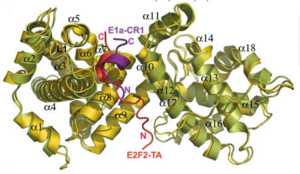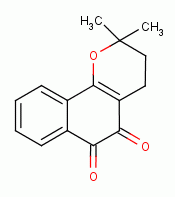Retinoblastoma protein
From Proteopedia
Retinoblastoma Protein (pRb) and E2FThe weighs 110 kDa. It is a tumor suppressor protein that prevents excessive cell growth. If not mutated, it is present in our cells and blocks the growth of dysfunctional cells between the G1 and S phase of the cell cycle before they can undergo DNA replication. pRb also regulates the function of cyclin and cyclin dependent kinase (CDK) complexes which are needed for the cell to proceed with cell growth. E2F is a transcription factor that forms a complex with pRb to inhibit cell growth. When E2F is not bound to pRb it encourages cells to proliferate, it's main function is to express genes required for DNA replication to take place. Retinoblastoma protein is dependent on the transcription factor E2F, which is bound to pRb's active site when it is hypo phosphorylated. In viral cells, and in tumorous cells pRb is dysfunctional or completely lost.If there is a mutation in this gene, it's binding domain is dysfunctional and can lead to excessive cell growth, which may cause tumor or cancer development. See also Rtp and Tus DNA Binding. pRb/EF binding in the cell cycleA cell must go through the cell cycle in order to grow, and replicate, and before it can replicate it has to pass through the many phases of the cell cycle. The cell cycle consists of the Go phase, also known as the resting phase in which the cell exits from the cell cycle, and can remain dormant forever. Then comes the Gap-1 phase in which cell growth takes place. Next is the R-phase restriction point that determines if the cell is ready to move on to the Synthesis phase (S-phase), which is when the cell’s DNA is replicated. It moves on to the Gap-2 phase and finally the Mitosis phase where the cell divides. The phases where pRB and E2F function are necessary are during the Go phase, and during the restriction point. In these phases pRb will inhibit cell growth, and determine if the cell can transition from the G1 phase to the S phase. If the cell is not growing adequately, for example if its DNA is damaged, then the retinoblastoma protein will hypo-phosphorylate and bind to the E2F transcription factor.This triggers the inhibition of E2F and of cyclin CDK complexes, and pRb is activated to stop cell growth. When pRB is phosphorylated, it no longer inhibits cell growth and the cell can continue developing. Phosphorylation of retinoblastoma is caused by the cyclin CDK complexes that are active throughout the cell cycle, in particular cyclin E an D, and cyclin dependent kinases 2, 4 and 6. It is important for retinoblastoma to function properly between the Gap-1 and S-phase, if retinoblastoma is disturbed then cell replication is not inhibited, this will allow replication of cells carrying damaged DNA.[1] Specific Binding sites of pRb/E2F complexWhen pRB and E2F form a complex, pRB is activated, and therefore inhibits cell growth. E2F is a family of transcription factors E2F-1, E2F-2, E2F-3, E2F-4, and E2F-5. Specifically, E2F-1, E2F-2, E2F-3,and E2F-4 bind to retinoblastoma during the G0,Gap-1, and S stages of the cell cycle. This complex is held together by many weak interactions, such as hydrophobic interactions, hydrogen bonds, and a salt bridge. The retinoblastoma protein’s active site is composed of two domains. , which form the pRB pocket domain that E2F can bind to, the C-terminal residues on pRb are also necessary for E2F to bind with a higher affinity. Specifically, E2F binds to the α4, α5, α6, α8, and α9 helices of the A domain, and only bind to the α11 helix of the B domain (see figure to the right). This structure was obtained through a diffraction image from a diffractometer [2]. They also found that of the entire E2F complex only the two end regions are needed to bind pRb, the marked box region and the transactivation domain which is composed of residues 243-437.[3] There are 18 residues of the E2F protein that are involved in the pRb/E2F complex (left figure), residues 409-426. Within this E2F region, there are 5 essential amino acids that if altered, would cause the complex to fall apart. These amino acids are the following: binds to pRB via a hydrophobic pocket created by phenolic ring with isoluecine amino acids on the A domain of pRb, and a hydrogen bond created by the hydroxyl group on the phenol ring. Leu(424) and Phe(425) both form many hydrophobic interactions. (in light green) hydrogen bonds to Thr(645) of pRB, and (in light purple) forms a salt bridge with Arg(467) on pRB [3]. Any point mutations of any of these amino acids will block binding of pRb, leading to deactivation of pRb’s cell inhibiting function, and will allow E2F to promote the cell cycle to move on to the S-phase. Activation/ Deactivation of pRBActivation of retinoblastoma protein occurs when it is hypophosphorylated, bound to E2F, and is not mutated. When hypophosphorylated, it inactivates cdk-cyclin complexes and is tightly bound to E2F. A non mutated pRb protein can undergo proper phosphorylation and proper binding to E2F. There are also many ways to inactivate pRb, phosphorylation of pRb, interaction with viral proteins, mutation of the pRb gene, and via the Caspade-mediated degradation.[3] PhosphorylationPhosphorylation of pRb is caused by binding of Cyclin dependent kinase and Cyclin complexes such as cdk4/6-cyclin D and cdk2-cyclin E.[4] This will prevent binding free pRb to E2F, or can cause the pRb/E2F complex to fall apart. Now that E2F is free, it can activate the progression of the cell though to S-phase. is a specific amino acid that undergoes phosphorylation, and has been observed to disrupt the A and B-domain binding site of pRb.[3] Viral oncoproteinspRb can interact with viral oncoproteins. These viral oncoproteins contain a strictly conserved LXCXE motif that allows them to bind to the retinoblastoma A and B pocket domain or at any other sites of the pRb protein such as the c-terminal. Binding of a viral protein out competes binding of E2F, therefore causing E2F to detach from pRb.. Examples of these viral genes are E7 oncoprotein of the Human papillomavirus (HPV), the adenovirus E1A which encodes potential oncoproteins that alter cell control, and the SV40 antigen which is a DNA virus that can cause tumors.[5]. The figure to the right shows binding of E1A adenovirus to pRb, and displacement of E2F. E1A binds deep within the A and B pocket domains, mainly it binds to alpha-4,5,6,8, and 11 helices of the pocket domain[5] Biding of viral oncoproteins disrupts the pRb/E2F complex, allowing E2F to activate the cell cycle. See also Proteins involved in cancer. Mutations of pRbAny mutation of the pRb gene will disrupt its proper function. If mutated, pRb can me either present and dysfunctional, or completely absent. Mutated pRb has been found in many human tumors, such as osteosarcoma, which is a cancerous bone tumor, cell lung carcinomas and breast carcinomas that arise from cells whose genome has been altered. Caspade-Mediated degradationThe Caspade-Mediated degradation is a type of cleavage that leads to pRb degradation. Lysing occurs between Asp (886) and Gly (887), which then allows a Tumor Nacrosis factor (TNF) to stimulate inhibition of pRb.[3] Tumors, cancer and treatmentsDisruption of the pRb/E2F complex has been discovered in many human tumors and cancers. Alteration of this complex results in free E2F transcription factor that accumulates in the cell and allows cells to proliferate. E2F has different roles in various cancers and tumors. Studies done on breast carcinomas, prostate adenocarcinomas, colon adenocarcinomas, and bladder carcinomas, showed that expression of E2F was higher than in regular cells. E2F was found to either allow malignant cells to proliferate or to counterpart with tumor growth. Studies of the retinoblastoma protein and E2F transcription factor have been done to somehow find a treatment for cancer. A compound, β-Lapachone that comes from trees in South America, is currently used as a drug for cancer treatment. It functions to inhibit proliferation of cells by enhancing the binding of the pRb/E2F complex. It also inhibits the function of cyclin E, and cyclin dependent kinase to block pRb phosphorylation. β-Lapachone also induces cell apoptosis, and reacts with many other transcription factors to stop uncontrollable cell growth.[6]. The pRb/E2F complex is very important for normal cell growth in our bodies, without proper function of it, humans are prone to the development of tumors, malignant cells, and cancer. | ||||||||||||
3D structures of retinoblastoma protein
Updated on 13-February-2022
References
- ↑ http://genesdev.cshlp.org/content/9/23/2873.full.pdf
- ↑ Xiao B, Spencer J, Clements A, Ali-Khan N, Mittnacht S, Broceno C, Burghammer M, Perrakis A, Marmorstein R, Gamblin SJ. Crystal structure of the retinoblastoma tumor suppressor protein bound to E2F and the molecular basis of its regulation. Proc Natl Acad Sci U S A. 2003 Mar 4;100(5):2363-8. Epub 2003 Feb 21. PMID:12598654 doi:10.1073/pnas.0436813100
- ↑ 3.0 3.1 3.2 3.3 3.4 http://hosted2.roswellpark.org/o4s/audio/references/Black5_090706.pdf
- ↑ Nevins JR. The Rb/E2F pathway and cancer. Hum Mol Genet. 2001 Apr;10(7):699-703. PMID:11257102
- ↑ 5.0 5.1 Liu X, Marmorstein R. Structure of the retinoblastoma protein bound to adenovirus E1A reveals the molecular basis for viral oncoprotein inactivation of a tumor suppressor. Genes Dev. 2007 Nov 1;21(21):2711-6. PMID:17974914 doi:21/21/2711
- ↑ http://www.jbmb.or.kr/jbmb/jbmb_files/%5B36-2%5D0303211840_223-229.pdf
Proteopedia Page Contributors and Editors (what is this?)
Yvonne Alva, Michal Harel, Joel L. Sussman, Alexander Berchansky
